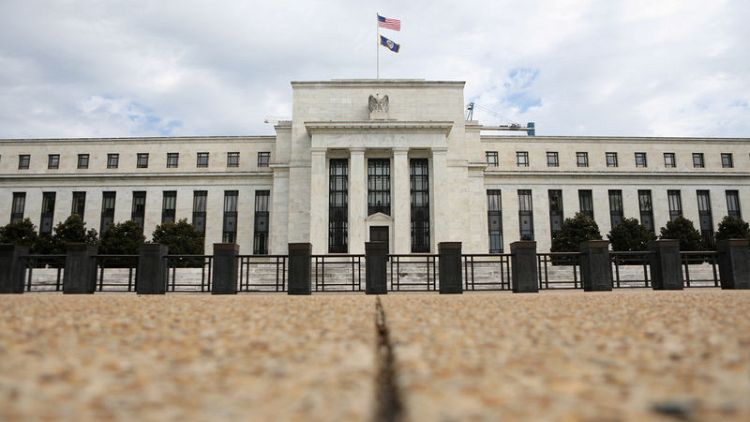WASHINGTON (Reuters) - The Federal Reserve concludes its latest two-day policy meeting on Wednesday to set a key U.S. interest rate that impacts investors, consumers, and companies around the world.
After closed-door deliberations, policymakers are expected to announce at 2 p.m. EDT (1800 GMT) whether they've cut the benchmark rate that banks charge each other for overnight loans, as they try to keep the world's largest economy stable and inflation under control.
Here's a primer on how the nation's central bank decides monetary policy:
WHO ARE THE FED'S POLICYMAKERS?
Fed policymakers include the five current members of the central bank's board of governors, all based in Washington, and the 12 heads of the regional Fed banks located around the country, from Boston to Atlanta to Kansas City to San Francisco.
The governors are nominated by the U.S. president, confirmed by the Senate, and serve 14-year terms. The current set-up is based on a system signed into law by President Woodrow Wilson in 1913, but it can trace its roots to the first Treasury Secretary Alexander Hamilton.
Jerome Powell, a former investment banker, chairs the Fed's board of governors, and is seen as the world's most powerful central banker due to the outsized influence the Fed's decisions have on financial markets around the world.
He took up the post in February 2018 after being nominated by President Donald Trump, who has since taken to railing against the Fed chief and the central bank for not making deeper rate cuts.
Fed bank chiefs are picked by their local boards, not by politicians, and serve five-year terms that are typically renewed until retirement.
DO ALL POLICYMAKERS VOTE ON INTEREST RATES?
No. Although all 17 policymakers take part in two days of deliberations, only the 10 members of the Federal Open Market Committee vote on interest rates.
Each Fed governor has a permanent vote, as does the head of the New York Fed. The remaining four votes are rotated annually among the other 11 regional Fed presidents in a design that is meant to balance the views of those who are politically appointed with those more closely tied into local economies.
This year, the heads of the Boston, Kansas City, St. Louis and Chicago Fed banks have a vote. Voters and non-voters alike participate in the discussions about setting interest rates and contribute to the FOMC's assessment of the economy and monetary policy options.
HOW OFTEN DO THEY MEET AND WHERE?
The nation's 17 central bankers meet eight times a year, or roughly every six weeks, at the Fed's headquarters in Washington.
They gather in a large boardroom for a two-day discussion each time. Their decision on interest rates is then released simultaneously by the media and on their website at 2 p.m. EDT on the second day of the meeting, nearly always a Wednesday.
Since January, Powell has held a news conference after every meeting that has been streamed live on the Fed's website at 2:30 p.m. EDT, where he explains the committee's reasons for their decision and answers questions from reporters.
HOW ARE DECISIONS ABOUT RATES MADE?
The policymakers base their assessment on whether to raise, hold steady or cut interest rates on how they think the economy is currently performing and how they think it will do in coming months.
At every policy meeting, Fed staff present an overview of the data that has come in since the last meeting.
Those data points include the Labor Department's monthly jobs report and other economic growth indicators, inflation measures, and consumer and business sentiment surveys.
Policymakers usually take turns giving their view of the economy. They often reference the situation in their own part of the country and their own conversations with local business leaders.
By the second day of the meeting, the discussion usually focuses on the policy decision itself, meeting transcripts that are released five years later show. Policymakers deliberate on the exact language that will be used to describe their decision, possible versions of which will have been circulated internally beforehand.
WHY IS THE MEETING SO IMPORTANT?
The Fed sets a target range for the rate banks charge each other for overnight lending, known as the federal funds rate. Changes in that rate typically affect the longer-term rates that banks charge customers, and determine borrowing costs for mortgage, credit card, and business loans. The Fed does not control those rates directly.
To keep the fed funds rate within its targeted range, the Fed uses a number of tools, including the interest rate it pays to banks for holding excess reserves at the central bank, and the rate it pays on certain money market operations.
WHAT'S HAPPENED SO FAR THIS YEAR?
After raising the central bank's key overnight lending rate to a target range of 2.25% to 2.5% in December 2018, the Fed reversed gear this year in the face of slowing global growth and the negative impact of the U.S.-China trade war on the U.S. manufacturing sector and business investment.
In what Powell has described as "insurance" against those headwinds, the Fed cut interest rates by a quarter of a percentage point in July. It followed that with another quarter-percentage point cut at its next meeting in September.
Those decisions were not unanimous. At the September meeting, the committee voted 7-3 for a rate cut. Of the three policymakers who dissented, two wanted the Fed to keep rates unchanged and a third wanted a deeper cut. When views within the Fed are divided, the central bank's chief will sometimes make small changes to the statement describing the policy move so as to win support from as broad a group as possible.
WHAT'S EXPECTED TO HAPPEN THIS TIME AND WHY?
Between meetings, most policymakers give speeches and interviews offering their current assessment of the economy. Investors and economists pay close attention to any signals, particularly from Powell and other senior leadership, in an attempt to anticipate what might happen at the next meeting.
According to the CME Group's FedWatch tool, investors are overwhelmingly betting on a rate cut this time. The Fed is expected to lower borrowing costs by another quarter of a percentage point to a range of between 1.5% and 1.75%.
(Reporting by Lindsay Dunsmuir and Ann Saphir; Editing by Heather Timmons and Paul Simao)



